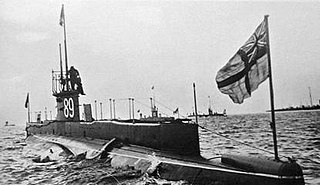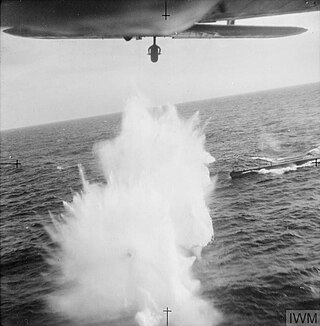Underwater speed record include records for submarines, autonomous underwater vehicles, and torpedoes. As these are typically for military vehicles, most are unconfirmed.
Contents

Underwater speed record include records for submarines, autonomous underwater vehicles, and torpedoes. As these are typically for military vehicles, most are unconfirmed.

Established reports and manufacturer's claims indicate that a handful of submarines are capable of speeds exceeding 30 knots (56 km/h; 35 mph). In 1960, HMS Explorer S30 achieved an underwater speed of over 30 knots [1] . In 1965, the experimental USS Albacore reported a speed of 33 knots (61 km/h; 38 mph). [2] The Soviet November-class submarine was found in 1968 to have a speed of 31 knots (57 km/h; 36 mph). [3] In response the United States Navy developed the Los Angeles-class submarine, with a reported speed of 30–32 knots (56–59 km/h; 35–37 mph). The Akula (Russian: shark)-class vessel is reportedly capable of travelling submerged at 35 knots (65 km/h; 40 mph). Its predecessor, the Alfa class, could attain short speed bursts of 40–45 knots (74–83 km/h; 46–52 mph) while submerged. [4] [5] There are also claims that the Soviet twin-propeller submarine K-222 , with titanium inner and outer hulls, reached 44.7 knots (83 km/h; 51 mph), fully submerged, during sea trials in 1969.
The British Spearfish torpedo, designed to counter high-speed Russian submarines such as the Alfa class, is reputed to reach speeds in excess of 70 knots (130 km/h; 81 mph). The Russian VA-111 Shkval rocket-powered supercavitating torpedo is reportedly capable of speeds over 200 knots (370 km/h; 230 mph). [6] The German press reported on an underwater anti-torpedo missile, formerly named Barracuda, allegedly capable of reaching 430 knots (800 km/h). [7]

Supercavitation is the use of a cavitation bubble to reduce skin friction drag on a submerged object and enable high speeds. Applications include torpedoes and propellers, but in theory, the technique could be extended to an entire underwater vessel.

The Alfa class, Soviet designation Project 705 Lira, was a class of nuclear-powered attack submarines in service with the Soviet Navy from 1971 into the early 1990s, with one serving later with the Russian Navy until 1996. They were among the fastest military submarines ever built, with only the prototype submarine K-222 exceeding them in submerged speed.

HMS J1 was a J-class submarine operated by the Royal Navy and the Royal Australian Navy.

HMS J2 was a J-class submarine operated by the Royal Navy and the Royal Australian Navy.
HMS J3 was a J-class submarine operated by the Royal Navy and the Royal Australian Navy.

HMS J5 was a First World War J class submarine operated by the Royal Navy and the Royal Australian Navy.

The VA-111 Shkval torpedo and its descendants are supercavitating torpedoes originally developed by the Soviet Union. They are capable of speeds in excess of 200 knots.

The British L-class submarine was originally planned under the emergency war programme as an improved version of the British E-class submarine. The scale of change allowed the L class to become a separate class.
The R-class submarines were a class of 12 small British diesel-electric submarines built for the Royal Navy during World War I, and were forerunners of the modern attack submarine, in that they were designed specifically to attack and sink enemy submarines, their battery capacity and hull shape being optimized for underwater performance.
HMS R4 was one of 10 R-class submarine built for the Royal Navy during the First World War. The boat was not completed before the end of the war and was sold for scrap in 1934.

HMS E9 was a British E class submarine built by Vickers, Barrow. She was laid down on 1 June 1912 and was commissioned on 18 June 1914.
HMS E12 was a British E class submarine built by HM Dockyard, Chatham. She was laid down on 16 December 1912 and commissioned on 14 October 1914. Her construction costs totalled £101,900.

HMS H32 was a H-class submarine constructed for the Royal Navy. The submarine entered service in 1919 and served in the Second World War, one of only seven of the class to do so. During Warship Week 1942 H32 was adopted by Lydney RDC (Gloucestershire). The submarine was sold for scrap in 1944.
K-64 was the lead ship of the Project 705 nuclear-powered attack submarines of the Soviet Navy.

HMS E20 was a British E-class submarine built by Vickers, Barrow-in-Furness. She was laid down on 25 November 1914 and was commissioned on 30 August 1915. She was sunk, torpedoed by UB-14, on 6 November 1915.
HMS E46 was a British E-class submarine built by Cammell Laird, Birkenhead. She was launched on 4 April 1916 and was commissioned in October 1916. HMS E46 was sold in South Wales on 6 September 1922.
HMS E38 was a British E-class submarine built by Fairfield, Govan, Clyde. She was launched on 13 June 1916 and commissioned on 10 July 1917. E38 was sold for scrap in Newport on 6 September 1922.

German submarine U-705 was a Type VIIC U-boat of Nazi Germany's Kriegsmarine during World War II.

HMS Rainbow was a Rainbow-class submarine built for the Royal Navy during the 1930s.

German submarine U-1014 was a Type VIIC/41 U-boat of Nazi Germany's Kriegsmarine during World War II.